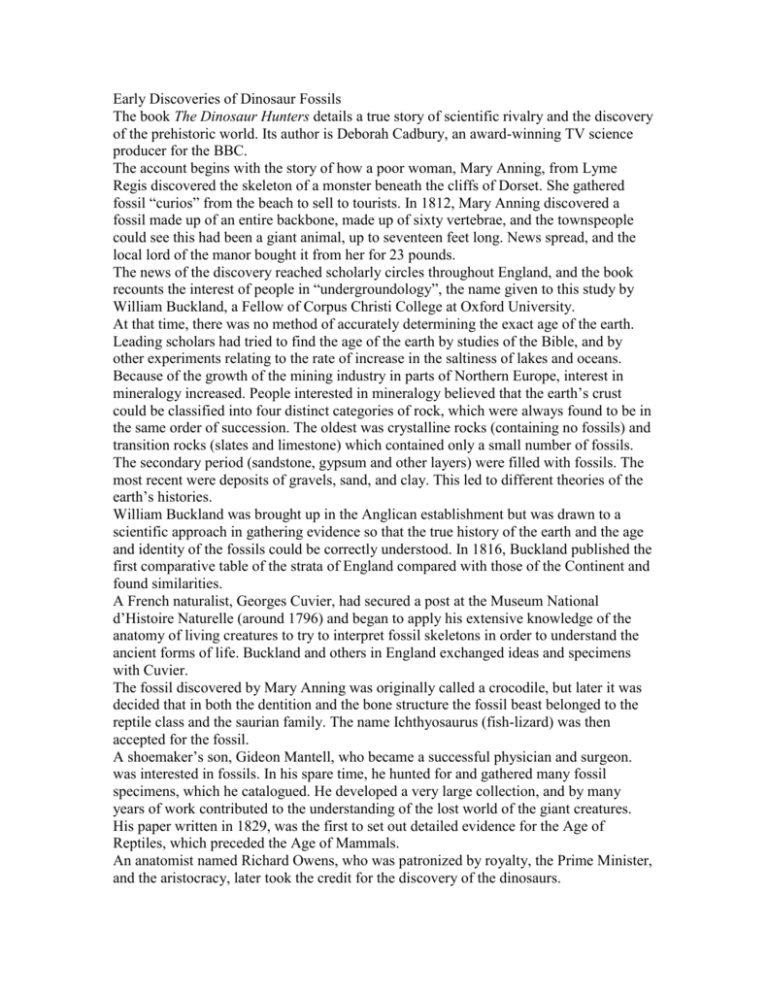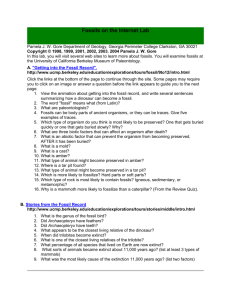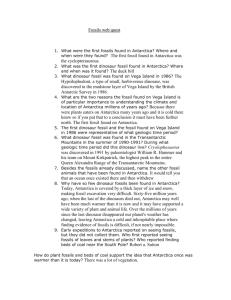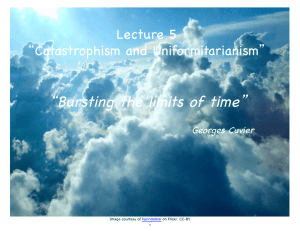MS Word file - Las Positas College
advertisement

Early Discoveries of Dinosaur Fossils The book The Dinosaur Hunters details a true story of scientific rivalry and the discovery of the prehistoric world. Its author is Deborah Cadbury, an award-winning TV science producer for the BBC. The account begins with the story of how a poor woman, Mary Anning, from Lyme Regis discovered the skeleton of a monster beneath the cliffs of Dorset. She gathered fossil “curios” from the beach to sell to tourists. In 1812, Mary Anning discovered a fossil made up of an entire backbone, made up of sixty vertebrae, and the townspeople could see this had been a giant animal, up to seventeen feet long. News spread, and the local lord of the manor bought it from her for 23 pounds. The news of the discovery reached scholarly circles throughout England, and the book recounts the interest of people in “undergroundology”, the name given to this study by William Buckland, a Fellow of Corpus Christi College at Oxford University. At that time, there was no method of accurately determining the exact age of the earth. Leading scholars had tried to find the age of the earth by studies of the Bible, and by other experiments relating to the rate of increase in the saltiness of lakes and oceans. Because of the growth of the mining industry in parts of Northern Europe, interest in mineralogy increased. People interested in mineralogy believed that the earth’s crust could be classified into four distinct categories of rock, which were always found to be in the same order of succession. The oldest was crystalline rocks (containing no fossils) and transition rocks (slates and limestone) which contained only a small number of fossils. The secondary period (sandstone, gypsum and other layers) were filled with fossils. The most recent were deposits of gravels, sand, and clay. This led to different theories of the earth’s histories. William Buckland was brought up in the Anglican establishment but was drawn to a scientific approach in gathering evidence so that the true history of the earth and the age and identity of the fossils could be correctly understood. In 1816, Buckland published the first comparative table of the strata of England compared with those of the Continent and found similarities. A French naturalist, Georges Cuvier, had secured a post at the Museum National d’Histoire Naturelle (around 1796) and began to apply his extensive knowledge of the anatomy of living creatures to try to interpret fossil skeletons in order to understand the ancient forms of life. Buckland and others in England exchanged ideas and specimens with Cuvier. The fossil discovered by Mary Anning was originally called a crocodile, but later it was decided that in both the dentition and the bone structure the fossil beast belonged to the reptile class and the saurian family. The name Ichthyosaurus (fish-lizard) was then accepted for the fossil. A shoemaker’s son, Gideon Mantell, who became a successful physician and surgeon. was interested in fossils. In his spare time, he hunted for and gathered many fossil specimens, which he catalogued. He developed a very large collection, and by many years of work contributed to the understanding of the lost world of the giant creatures. His paper written in 1829, was the first to set out detailed evidence for the Age of Reptiles, which preceded the Age of Mammals. An anatomist named Richard Owens, who was patronized by royalty, the Prime Minister, and the aristocracy, later took the credit for the discovery of the dinosaurs.







